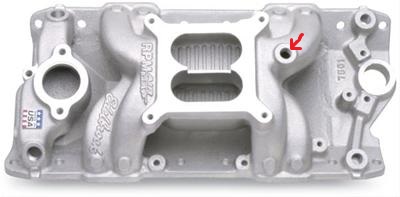locating those intake manifold or other vacuum leaks
is fairly easy if you have a tachometer and a propane torch
yeah the way I find vacuum leaks on carb OR MPFI intake manifolds is clean and easy with no mess. get a propane torch,or you can use your oxy-acetylene welding torch if you have one, (DON,T TURN THE OXYGEN tank/or OXYGEN valve, on the torch ON)
http://www.corvette-101.com/vacuum.htm
viewtopic.php?f=50&t=11089
WATCH THE VIDEO, READ THE LINKS
http://www.youtube.com/watch?v=9CPqbaSg ... re=related
viewtopic.php?f=50&t=1877&p=4936#p4936
you might find the next vacuum leak a bit faster with this method, as you can much more precisely direct the combustible gas flow, at any suspect leak location

(DONT LIGHT IT) just SLIGHTLY open the valve so its allowing gas to flow at a low volume,start the engine and let it idle at the lowest speed you can then place the tip of the UNLIT torch at any suspected vacuum leak and listen for the rpms to increase and watch the tachometer, gas flowing into a vacuum leak will increase engine speed.
look for loose or missing vacuum hoses, cracked or broken power brake connections, emissions system hoses that are loose, vacuum connections to the trans or ignition, loose connectors missing or loose bolts cracked hoses missing accessory connections etc.
naturally this only locates leaks to the outside, and its possible for the intake to suck air from the lifter gallery, so that also needs to be checked if everything else seems to be ok.
http://www.centuryperformance.com/tunin ... g-148.html
http://www.secondchancegarage.com/public/186.cfm
read this
viewtopic.php?f=44&t=464
http://www.centuryperformance.com/tunin ... g-148.html
http://garage.grumpysperformance.com/index.php?threads/fuel-pressure-drops.12123/#post-58318
is fairly easy if you have a tachometer and a propane torch
yeah the way I find vacuum leaks on carb OR MPFI intake manifolds is clean and easy with no mess. get a propane torch,or you can use your oxy-acetylene welding torch if you have one, (DON,T TURN THE OXYGEN tank/or OXYGEN valve, on the torch ON)
http://www.corvette-101.com/vacuum.htm
viewtopic.php?f=50&t=11089
WATCH THE VIDEO, READ THE LINKS
http://www.youtube.com/watch?v=9CPqbaSg ... re=related
viewtopic.php?f=50&t=1877&p=4936#p4936
you might find the next vacuum leak a bit faster with this method, as you can much more precisely direct the combustible gas flow, at any suspect leak location

(DONT LIGHT IT) just SLIGHTLY open the valve so its allowing gas to flow at a low volume,start the engine and let it idle at the lowest speed you can then place the tip of the UNLIT torch at any suspected vacuum leak and listen for the rpms to increase and watch the tachometer, gas flowing into a vacuum leak will increase engine speed.
look for loose or missing vacuum hoses, cracked or broken power brake connections, emissions system hoses that are loose, vacuum connections to the trans or ignition, loose connectors missing or loose bolts cracked hoses missing accessory connections etc.
naturally this only locates leaks to the outside, and its possible for the intake to suck air from the lifter gallery, so that also needs to be checked if everything else seems to be ok.
http://www.centuryperformance.com/tunin ... g-148.html
http://www.secondchancegarage.com/public/186.cfm
read this
viewtopic.php?f=44&t=464
http://www.centuryperformance.com/tunin ... g-148.html
http://garage.grumpysperformance.com/index.php?threads/fuel-pressure-drops.12123/#post-58318
Last edited by a moderator:





